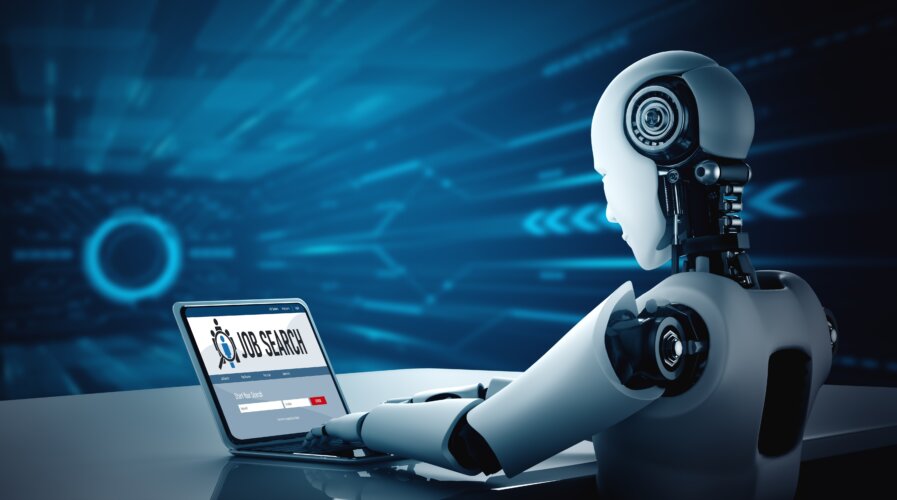
Some roles could eventually be replaced by technology. (Image – Shutterstock)
UN study: Policies are needed so that AI will not destroy jobs
• Generative AI may eradicate some repetitive jobs.
• The UN recommends strong action to maintain human roles.
• Many roles may be augmented, rather than destroyed.
The increasing adoption of generative AI in the workplace does not necessarily mean jobs will be replaced. While the consensus among employees whenever emerging technologies are adopted in the workplace is that it helps them deliver more and stronger, many also fear that the technology could replace them.
In fact, there has been growing concern that AI will eventually replace all non-essential jobs in all industries. The capabilities of generative AI have proven to make some jobs redundant, especially repetitive roles that don’t require high levels of human skill.
In the US, according to a report by McKinsey, by 2030, activities that currently account for up to 30% of hours worked across the US economy could be automated, a pre-existing trend significantly accelerated by generative AI. McKinsey also revealed that AI and automation’s biggest effects are likely to hit non-STEM jobs.
“Although generative AI is still in the early stages, the potential applications for businesses are significant and wide-ranging. Generative AI can be used to write code, design products, create marketing content and strategies, streamline operations, analyze legal documents, provide customer service via chatbots, and even accelerate scientific discovery. It can be used on its own or with ‘humans in the loop’; the latter is more likely at present, given its current level of maturity,” the report said.
IDC reports that organizations in the Asia Pacific region lead in terms of prioritizing generative AI investments due to their proactive stance on new technologies and government support. IDC Survey data shows that two-thirds of AP organizations are exploring potential use cases or are already investing in generative AI technologies in 2023.

McKinsey research estimates automation could take over tasks accounting for 21.5% of the hours worked in the US economy.
United Nations believes AI can enhance some roles
Meanwhile, a new study by the United Nations International Labor Organization showed that most jobs and industries are only partially exposed to automation. The researchers behind the study believe that these roles are more likely be complemented instead of substituted by AI.
As such, the study indicates that the greatest impact of AI is not the destruction of jobs, but rather an enhancement of the quality of work. At the same time, researchers also pointed out that AI is likely to have disruptive effects on labor markets, with larger effects in high-income countries and specific occupational groups.
“A potentially more significant consequence of wider adoption of generative AI products could be an increased divergence in productivity between the high- and low-income countries. Larger shares of jobs falling into the augmentation category suggest that, at least in the near future, generative AI systems similar to GPT are more likely to become productivity tools, supporting and speeding up the execution of some tasks within certain occupations. The digital divide will influence how the benefits of such productivity tools are distributed among societies and countries, with high-income countries and privileged groups likely to reap the biggest rewards,” the study stated.
While middle-income countries are more exposed to the automating effects of GPT technologies, their digital infrastructure and skilled workforce can also be assets for spawning the growth of complementary industries.
For example, the call center industry, which is currently dominated by India and the Philippines, is at risk of losing some work once AI kicks in. However, the researchers believe that their dominance in the industry is still needed, to lay the foundation for the development of new industries.

Clerical jobs could be among those most likely to be subsumbed by AI.
Another finding from the study is that the potential effect of AI is likely to differ significantly for men and women. In fact, the study finds that female employment is more than twice as likely to be potentially affected by automation. This is due to women’s over-representation in clerical work, especially in high- and middle-income countries.
Clerical jobs include roles in administration, human resources, and other tasks that AI can easily automate and replace. The study also pointed out that since clerical jobs have traditionally been an important source of female employment as countries develop economically, one result of AI could be that certain clerical jobs may never emerge in lower-income countries.

Should employees be worried about AI taking over their jobs? (Image – Shutterstock)
Will AI take over jobs?
While the UN study has reiterated that AI will not destroy jobs, the reality is that AI is slowly taking over more jobs. The increasing adoption of automation tools in warehouses, call centers, and even in client-facing roles just shows how some roles are hanging by a thread right now.
Take warehouses, for example. Generally, most work involves workers sorting goods, driving trucks and cranes, and packing. Today, AI can automate almost every process in the warehouse, from inventory management all the way to packing, sorting, and even delivery through autonomous vehicles. While this is astonishing, the workers now face a problem. Not every worker in a warehouse is capable of picking up new skills and understanding technology, and part of the economic argument for technological automation depends on reducing the human wage bill.
Another example is how AI is taking over jobs in offices. Tech companies like IBM have already indicated that non-client-facing roles may eventually be fully replaced by AI. In fact, most big tech companies are reducing the number of employees whose roles can be performed by technology.
As the UN study clearly puts it, “Ultimately, we argue that in the realm of work, generative AI is neither inherently good nor bad, and that its socioeconomic impacts will largely depend on how its diffusion is managed. The questions of power balance, the voice of the workers affected by labor market adjustments, respect for existing norms and rights, and adequate use of national social protection and skills training systems will be crucial elements for managing AI’s deployment in the workplace.
Without proper policies in place, there is a risk that only some of the well-positioned countries and market participants will be able to harness the benefits of the transition, while the costs to affected workers could be brutal. Therefore, for policymakers, our study should not read as a calming voice, but rather as a call for harnessing policy to address the technological changes that are upon us.”
READ MORE
- Safer Automation: How Sophic and Firmus Succeeded in Malaysia with MDEC’s Support
- Privilege granted, not gained: Intelligent authorization for enhanced infrastructure productivity
- Low-Code produces the Proof-of-Possibilities
- New Wearables Enable Staff to Work Faster and Safer
- Experts weigh in on Oracle’s departure from adland






